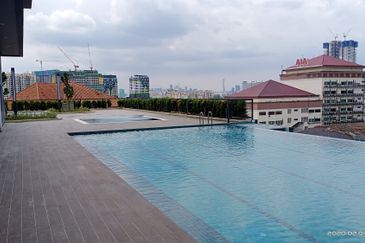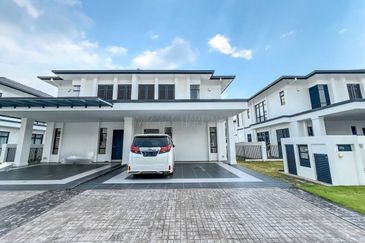
KUALA LUMPUR (July 22): It is a big relief to many, particularly Penangnites, when the federal government confirmed the project to expand the capacity of the Penang International Airport (PIA) to 20 million passengers per annum (mppa) from 6.5 million mppa currently.
The international airport in the tiny island served 7.8 million passengers in 2018 — four times more than its population of 1.76 million.
To triple the airport’s capacity, Finance Minister Lim Guan Eng was quoted by the media as saying the expansion could cost up to RM1.2 billion.
Another government official, however, told The Edge Financial Daily that the expansion might cost RM700 million. Since the details, such as whether there will be a swimming pool like in the Changi Airport, are not finalised yet, the total cost remains unknown.
That said, when contacted, Malaysia Airports Holdings Bhd (MAHB) confirmed with The Edge Financial Daily that the group has the financial strength to undertake the expansion.
“Yes, an application for Malaysia Airports to fully fund the [PIA expansion] project under the proposed Malaysian Aviation Commission (Mavcom) Regulated Asset Base (RAB) framework has been submitted and is now waiting for approval. Malaysia Airports is in a position to fully fund the project on its own,” it said in an email response.
Weeks ago, after Penang Chief Minister Chow Kon Yeow revealed that “certain issues” have hampered the progress of PIA expansion, MAHB issued a statement on July 2 saying it has obtained the ministry of finance’s approval to begin the project, and construction is expected to start in the first quarter of 2020.
However, this does not mean the federal government has given the green light for MAHB to solely fund and be in charge of the expansion, although MAHB is expected to be granted the project.
Like it or not, certain quarters could recall MAHB’s track record on the development of klia2 that cost RM3.98 billion. Until now, the facilities that have been put in place compared with the money spent remains a debatable issue. Also, the upgrading works of the PIA in 2010 ended up in a legal dispute with contractor Syarikat Pembinaan Anggerik Sdn Bhd.
“Like it or not, MAHB, although it operates many domestic airports for decades, is still lacking the experience of airport developments, a task undertaken by the government in the past.
“One question arises: Will MAHB be able to handle the procurement of such a large-scale project, one that could cost over RM1 billion?” asked an analyst who declined to be named.
The analyst stresses that procurement is an important part of the project that will determine the level of cost-efficiency and help to avoid any cost overrun.
Under the RAB, MAHB is incentivised to invest more in capital expenditure (capex) by giving the airport operator a certain rate of return for every ringgit spent in capex in the future.
It is worth noting that Transport Minister Anthony Loke understands that the main challenge to the domestic aviation sector is the government’s tight fiscal position, while the development of airport infrastructure requires big money. The RM40 billion allocation as development expenditure in the national budget is just not enough, he told The Edge Malaysia weekly in an interview in May.
Loke believes the country should leverage on the private sector, tapping its financial muscle and expertise, to develop and modernise the country’s 39 airports.
He is looking at introducing new operators, which could be foreign parties, for domestic airports. Should that pan out, there will be a healthy dose of competition, which will likely be a rude awakening for some quarters that are used to being in the dominant position all these years. To do that, the government has grouped the domestic airports into four clusters — one for KLIA, including klia2, another for designated airports in Peninsular Malaysia, and one each for airports in Sabah and Sarawak, under four new operating agreements (OAs).
Against this backdrop, some quarters think it will be interesting to see whether PIA’s expansion will pave the way for new investors to manage local airports. Currently, Tan Sri Syed Mokhtar Albukhary is the only other airport operator in Malaysia, besides MAHB. The tycoon operates the Senai International Airport in Johor.
Cost-efficiency a key
Industry players globally are comparing the cost of the PIA’s expansion with MAHB’s Istanbul Sabiha Gokcen International Airport (ISG) expansion, said an industry source.
The ISG, which commenced operations in October 2009, undertook an expansion to raise its capacity by 8 mppa from 33 mppa to 41 mppa at the cost of €26 million (RM120 million) last year.
The cost of the expansion has not been confirmed for now. Using the ISG as a yardstick, which might not be perfect due to possible variances in facilities and labour costs, based on a cost range of RM700 million to RM1.2 billion (which is several times more than the Turkish airport’s), it should be reasonable for Penangnites to expect a world-class airport.
In May, Guan Eng said the original proposal was to increase the PIA’s capacity from 6.5 mppa to 12 mppa. “We feel 12 million is too small, so we increased it to 16 million and if possible, 16 million plus four million so that the airport can cope until 2035,” he reportedly told local media.
TA Securities analyst Steve Tan Kam Meng is of the view that MAHB is likely to bag the project.
“In Mavcom’s second consultation paper on the aeronautical charges framework, MAHB said it intends to spend RM10 billion in capex over the next three years, and Mavcom limited it to around RM5 billion. We think the expenditure required for the PIA is already included in the RM5 billion capex,” he said over the phone.
Under the current OAs, any third party who intends to participate in the development of the PIA has to invest in the Peninsula Cluster, which comprises all airports in Peninsular Malaysia, except for KLIA and klia2.
Maybank Kim Eng analyst Mohshin Aziz said the PIA is one of the highly profitable airports in the portfolio, beside the Sultan Abdul Aziz Shah Airport in Subang. These two profitable international airports are currently cross-subsidising the airports with lower traffic, like the ones in Alor Setar, Melaka, Kuantan and Ipoh. But the analyst is not aware if government is bringing in new investors to operate local airports.
The PIA’s expansion will not strain the federal government’s fiscal position as it will be financed by the private sector. Still, airports are public utility, so the government has a part to play in ensuring that consumers are not exploited by overpriced investments.
The new government has been able to slash costs for several mega infrastructure projects, namely the East Coast Rail Link, mass rapid transit 2 and light rail transit 3. Will the airport expansion in Penang be another test for the new government?
This article first appeared in The Edge Financial Daily, on July 22, 2019.
TOP PICKS BY EDGEPROP

Bandar Springhill
Port Dickson, Negeri Sembilan

The Sky Residence @ Shamelin
Cheras, Kuala Lumpur

Jalan Spektrum U16 @ Taman Bukit Subang
Shah Alam, Selangor

Park Place 1 Commercial Centre
Cybersouth, Selangor

Norton Garden Semi D @ Eco Grandeur
Bandar Puncak Alam, Selangor




















